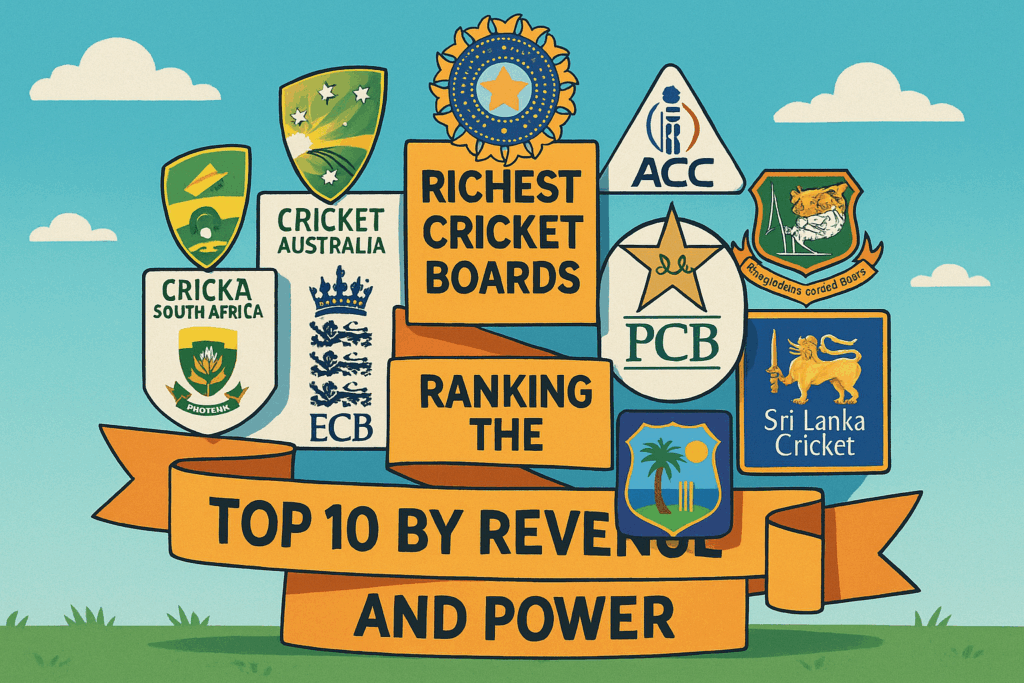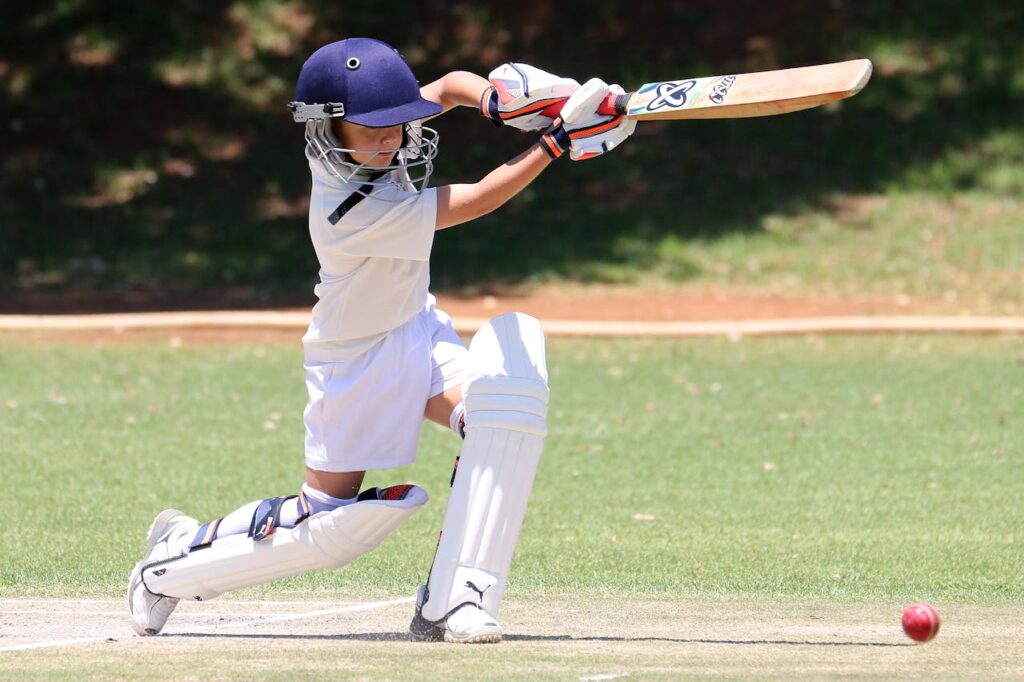In a world where sporting organizations are judged as much by their balance sheets as their silverware, cricket’s financial landscape has undergone a seismic transformation. The once traditionally run cricket associations have evolved into billion-dollar entities wielding influence beyond the boundary ropes. Some sit atop mountains of media rights, others ride the wave of franchise T20 leagues, and a few thrive on legacy, patriotism, and die-hard fan bases.
The richest cricket boards today aren’t just stewards of the sport — they’re corporate giants with international strategies, high-stakes investments, and brand portfolios that rival the most elite sports clubs globally.
But who really governs the economics of modern cricket? Which cricket boards are driving the global narrative — and who are lagging behind? Let’s step into the boardrooms where cricket gets commercial.
Table of Contents
- Understanding Cricket’s Financial Ecosystem
- Revenue Streams Powering Cricket Boards
- Top 10 Richest Cricket Boards in the World
- BCCI (India)
- England and Wales Cricket Board (ECB)
- Cricket Australia (CA)
- Pakistan Cricket Board (PCB)
- Bangladesh Cricket Board (BCB)
- South Africa’s CSA
- Sri Lanka Cricket (SLC)
- New Zealand Cricket (NZC)
- West Indies Cricket Board (CWI)
- Zimbabwe Cricket
- Comparison Table: Revenue, Broadcast Rights & Fan Base
- The IPL Effect: How One League Changed the Game
- How ICC Distributes Revenue to Member Boards
- FAQs – Key Questions on Cricket Board Wealth
- Final Whistle: What’s Next for Cricket’s Financial Titans?
Understanding Cricket’s Financial Ecosystem
Before diving into figures and boardroom budgets, it’s important to grasp what feeds the economic engine of a cricket board. Money in cricket flows from a variety of sources — domestic and international. Broadcast rights sit at the pinnacle, delivering more revenue than gate receipts, merchandise, or even sponsorships.
In Test-loving nations, ticket sales and TV licensing once formed the backbone of revenue. But in today’s landscape, digital streaming platforms, league franchising, and the massive Indian market have entirely shifted the scale.
Even the traditionally influential International Cricket Council (ICC) finds its revenue heavily dependent on one board’s popularity: the BCCI.
Revenue Streams Powering Cricket Boards
| Revenue Source | Description |
|---|---|
| Broadcasting Rights | Selling rights to television channels and digital platforms |
| ICC Distributions | Revenue allocated by the ICC based on viewership and board equity |
| Sponsorships & Partnerships | Deals with corporations for team kits, stadiums, and series naming rights |
| Franchise League Royalties | Homegrown T20 leagues like IPL, BBL, PSL generating license revenues |
| Gate Receipts | Matchday ticket sales and stadium services |
| Merchandise Sales | Team jerseys, fan gear, and memorabilia |
| Government Funding | Select boards (mostly smaller ones) receive funds or grants from ministries |
Top 10 Richest Cricket Boards in the World (Ranked by Revenue and Net Worth)
Below we break down the financial behemoths of modern-day cricket. These rankings reflect a blend of total revenues, media rights valuations, assets, and long-term financial strategy.
1. Board of Control for Cricket in India (BCCI)
Headquarters: Mumbai, India
Est. Net Revenue: Over $1.5 billion annually
Key Assets: IPL, Hotstar rights, bilateral series, fan base
Fan Base Reach: Approx. 1.4 billion people
BCCI isn’t just the richest cricket board — it’s a financial titan even compared to other sports leagues globally. Its massive dominance stems from controlling the Indian Premier League (IPL), the most valuable cricket league in history. The board commands sky-high broadcast deals, with digital rights fetching billions over short cycles.
Add to this India’s cricket-crazy population, and BCCI effectively anchors the very economics of world cricket. With multi-brand sponsorships, lucrative jersey rights (now switching hands between fantasy firms, ed-techs, and telcos), the Indian board is the sport’s de facto commercial nerve center.
But BCCI’s influence isn’t all about chequebooks. Their power often translates into larger shares of ICC revenue and diplomatic sway in international scheduling.
2. England and Wales Cricket Board (ECB)
Headquarters: London, UK
Est. Net Revenue: ~$325 million
Key Assets: The Hundred, Ashes Broadcasts, ECB-Cricket Foundation
The ECB controls the richest cricketing rights outside Asia. The Ashes, pitting England against Australia, remains a huge money-spinner domestically and globally. Since the inception of The Hundred, an innovative limited-over tournament aimed at attracting younger demographics, the ECB has invested in reshaping cricket itself — with mixed financial results.
County cricket might no longer be their cash cow, but national contracts, TV deals with Sky Sports, and deep-rooted corporate partnerships keep this board firmly in the upper echelon of cricket’s elite.
3. Cricket Australia (CA)
Headquarters: Melbourne, Australia
Est. Net Revenue: ~$310 million
Key Assets: Big Bash League, Ashes, Fox Cricket Rights, Kayo Sports
With a mix of sporting prowess and commercial acumen, Cricket Australia monetizes its position in the Southern Hemisphere market effectively. Between the Big Bash League — one of the first successful T20 leagues — and marquee Test battles (especially vs India and England), CA’s TV deals drive significant income.
What’s unique here is CA’s ability to diversify earnings beyond just the national setup. Brand Australia itself has a global appeal, supported by a strong domestic fan base and modern infrastructural execution.
4. Pakistan Cricket Board (PCB)
Headquarters: Lahore, Pakistan
Est. Net Revenue: ~$125 million
Key Assets: Pakistan Super League, bilateral series with India (if any), ICC payouts
The wildcard entry among the rich boards, the PCB remains a paradox. With passionate home crowds and talent gushing from every street corner, their financial position doesn’t always reflect their cultural impact.
The launch of the Pakistan Super League (PSL) dramatically changed their earnings profile. Despite the region’s geopolitical challenges, the PCB continues to secure decent rights packages and sponsorships, especially when touring teams return to Pakistan.
5. Bangladesh Cricket Board (BCB)
Headquarters: Dhaka, Bangladesh
Est. Net Revenue: ~$110 million
Key Assets: BPL, massive national fan base, ICC matches
Don’t mistake lower rankings for a lack of power. The BCB brings one of the most enthusiastic cricketing audiences in Asia. Tickets sell briskly, and sponsors vie for visibility.
The Bangladesh Premier League (BPL), while inconsistent, still provides revenue streams. Moreover, BCB has invested in academy structures, stadium upgrades, and high-profile bilateral series to elevate its financial performance.
6. Cricket South Africa (CSA)
Headquarters: Johannesburg, South Africa
Est. Net Revenue: ~$100 million
Key Assets: SA20 League, international rights, strong grassroots systems
Despite financial turbulence in recent years, CSA has launched the SA20 franchise league to revive its income. Partnering with Indian IPL franchises has rejuvenated investor interest.
Funding shortfalls and political friction have hurt CSA’s growth trajectory, but its alumni and cricket infrastructure remain globally respected. Getting stable sponsors and post-Covid tours back on schedule has helped recovery.
7. Sri Lanka Cricket (SLC)
Headquarters: Colombo, Sri Lanka
Est. Net Revenue: ~$85 million
Key Assets: Lanka Premier League, strong ICC heritage, loyal audience
After the retirement of the golden generation, SLC entered turbulent financial waters. But with diligent restructuring, new league strategies, and regular ICC event participation, they’ve stabilized revenue.
Success of the LPL and marquee matches against India continue to finance operations. However, issues like match-fixing rumors and political interference remain existential threats to financial integrity.
8. New Zealand Cricket (NZC)
Headquarters: Auckland, New Zealand
Est. Net Revenue: ~$70 million
Key Assets: World Cup success, bilateral series, brand value of Kane-led teams
New Zealand consistently punches above its weight. Financially, however, their smaller population and domestic TV revenues limit earning potential.
They rely heavily on tours against higher-profile teams — especially India or Australia — to drive revenue. ICC event performances (like making World Cups finals) bring in temporary surges and sponsorship deals.
9. West Indies Cricket Board (CWI)
Headquarters: Antigua
Est. Net Revenue: ~$50 million
Key Assets: CPL, heritage value, fan nostalgia
Once unified by on-field dominance, West Indies cricket has become decentralized. The Caribbean Premier League (CPL) offers much-needed commercial spark, often sold well on international platforms dues to its scenic uniqueness and legacy.
CWI grapples with player contention and regional politics, both of which chip away at financial consistency.
10. Zimbabwe Cricket (ZC)
Headquarters: Harare
Est. Net Revenue: ~$25 million
Key Assets: ICC support, local series, emerging player pathway
Primarily sustained via ICC subsidies, ZC remains economically fragile. Decades of mismanagement and political interference have crippled earning power.
Yet, strong recent performances, youth programs, and renewed governance offer hope for a turnaround — and financial rebuilding.
Cricket Boards Ranked by Revenue – Comparison Table
| Rank | Cricket Board | Estimated Annual Revenue | Major Income Sources |
|---|---|---|---|
| 1 | BCCI (India) | $1.5+ billion | IPL, broadcast deals, ICC share |
| 2 | ECB (England) | ~$325 million | Ashes, The Hundred, TV sponsorships |
| 3 | CA (Australia) | ~$310 million | BBL, series with India & England |
| 4 | PCB (Pakistan) | ~$125 million | PSL, bilateral series, ICC events |
| 5 | BCB (Bangladesh) | ~$110 million | BPL, sponsorships, national matches |
| 6 | CSA (South Africa) | ~$100 million | SA20, TV rights, ICC grants |
| 7 | SLC (Sri Lanka) | ~$85 million | LPL, Indian series, ICC tournaments |
| 8 | NZC (New Zealand) | ~$70 million | Tours, ICC share |
| 9 | CWI (West Indies) | ~$50 million | CPL, foreign sponsorship, nostalgia value |
| 10 | ZC (Zimbabwe) | ~$25 million | ICC funding, grassroots development |
The IPL Effect: Why One League Reshaped Global Cricket Wealth
The BCCI’s masterstroke in launching the Indian Premier League revolutionized cricket’s entire economic ladder. With multi-billion-dollar media deals and holdings in digital streaming monetization, IPL’s success raised the market benchmark.
Its success pushed other boards to replicate models — think BBL, PSL, SA20, and The Hundred — though none have matched the IPL’s valuation. In economic terms, the IPL created a clear financial divide.
How ICC Revenue Is Shared Across Cricket Boards
The ICC distributes a portion of its central earnings—mainly from World Cup broadcasting and sponsorship—to Full Member and Associate boards. The BCCI, by virtue of its overwhelming market share, receives the biggest slice, sometimes over 35%. England, Australia, and Pakistan follow, with lesser shares trickling down to emerging nations.
This setup has created debates around equity. Smaller boards often rely heavily on this annual disbursement to remain solvent.
FAQs – Key Questions on Cricket Board Wealth
What is the richest cricket board in the world?
The BCCI dominates global cricket economics with revenues dwarfing all others combined.
How do cricket boards make money?
Primarily from media rights, franchise leagues, ICC tournaments, gate receipts, and sponsorships.
Which cricket board earns the most from the ICC?
BCCI receives the largest chunk of ICC distributions, followed by ECB, CA, and PCB.
What’s the impact of T20 leagues on board earnings?
Franchise leagues like IPL, PSL, BBL, and SA20 contribute massively to board earnings, often keeping them in surplus.
Is there a risk of over-reliance on IPL income?
Yes — for India and even for other boards that receive tour-based revenues when visiting India, which means global diversification is vital.
Final Whistle: What’s Next for Cricket’s Financial Titans?
The business of cricket is evolving — quickly and irreversibly. While traditional boards banked on heritage and bilateral cricket, the modern game finds its gold in leagues, digital broadcasts, and global fandom.
Boards that innovate — not just administratively, but financially — will lead the next wave. For now, the BCCI’s dominance remains unquestioned. But growth avenues lie open for those willing to play the long game.
The richest cricket boards may have their vaults full today, but it’s their vision that will decide the scoreboard of tomorrow.



